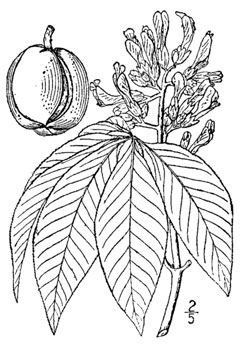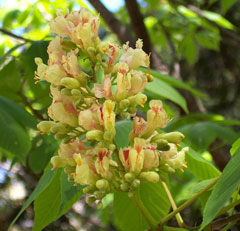 |
|
|
 |
| http://commons.wikimedia.org/wiki/File:Aesculus_flava.jpg |
Translate this page:
Summary
Bloom Color: Yellow.
Main Bloom Time: Early spring, Late spring, Mid spring. Form: Oval.
Physical Characteristics

 Aesculus flava is a deciduous Tree growing to 20 m (65ft) by 8 m (26ft) at a medium rate.
Aesculus flava is a deciduous Tree growing to 20 m (65ft) by 8 m (26ft) at a medium rate.
See above for USDA hardiness. It is hardy to UK zone 5 and is not frost tender. It is in flower from May to June, and the seeds ripen in September. The species is hermaphrodite (has both male and female organs) and is pollinated by Bees.
Suitable for: light (sandy), medium (loamy) and heavy (clay) soils and prefers well-drained soil. Suitable pH: mildly acid, neutral and basic (mildly alkaline) soils. It can grow in semi-shade (light woodland) or no shade. It prefers moist soil.
UK Hardiness Map
US Hardiness Map
Synonyms
Ae lutea. Ae octandra.
Plant Habitats
Woodland Garden Canopy;
Edible Uses
Edible Parts: Nectar Seed
Edible Uses:
Seed - cooked. Said to be as sweet as a chestnut[105, 177]. We have only eaten the immature seed, harvested in late August, but these were very tasty with no noticeable bitterness[K]. The seed can be up to 45mm in diameter and is easily harvested[82]. It can be dried, ground into a flour and used as a gruel. The seed contains saponins and needs to be leached of these toxins before it becomes safe to eat - the North American Indians would do this by slow-roasting the nuts (which would have rendered the saponins harmless) and then cutting them into thin slices, putting them into a cloth bag and rinsing them in a stream for 2 - 5 days[213, 229]. The resulting product is said to be tasty and nutritious[229], though most of the minerals etc would have been leached out[K]. The flowers contain a sweet nectar which is delicious when sucked out[245].
References More on Edible Uses
Medicinal Uses
Plants For A Future can not take any responsibility for any adverse effects from the use of plants. Always seek advice from a professional before using a plant medicinally.
None known
References More on Medicinal Uses
The Bookshop: Edible Plant Books
Our Latest books on Perennial Plants For Food Forests and Permaculture Gardens in paperback or digital formats.

Edible Tropical Plants
Food Forest Plants for Hotter Conditions: 250+ Plants For Tropical Food Forests & Permaculture Gardens.
More

Edible Temperate Plants
Plants for Your Food Forest: 500 Plants for Temperate Food Forests & Permaculture Gardens.
More

More Books
PFAF have eight books available in paperback and digital formats. Browse the shop for more information.
Shop Now
Other Uses
Soap Wood
Saponins in the seed are used as a soap substitute[169]. The saponins can be easily obtained by chopping the seed into small pieces and infusing them in hot water. This water can then be used for washing the body, clothes etc. Its main drawback is a lingering odour of horse chestnuts[K]. Wood - very soft, light, close grained, difficult to split. It weighs 27lb per cubic foot[235]. It is used for making artificial limbs, wooden ware, pulp etc, and is occasionally sawn into lumber[46, 62, 82, 171].
Special Uses
References More on Other Uses
Cultivation details
Landscape Uses:Pest tolerant, Pollard, Specimen. Prefers a deep loamy well-drained soil but is not too fussy[1, 11]. Grows best in eastern and south-eastern areas of England probably needing a continental climate in order to thrive[126, 200]. Although the trees are very hardy when dormant, the new growth can be damaged by late spring frosts[11]. Plants grow well in a woodland situation, tolerating shading by larger trees[229]. Seedlings grow away quickly, the plants reaching maturity when about 60 - 80 years old[229]. The form Asculus flava vestita (Sarg.)Fern. is growing well at Kew Gardens. It has been seen with large crops of fruit on a number of occasions, even in cooler summers. These fruits have only been tried when immature (harvested at the end of August) but were then very tasty with no bitterness[K]. Fruits are produced more abundantly in warm summers[130]. Most members of this genus transplant easily, even when fairly large[11]. Special Features:Attractive foliage, North American native, Blooms are very showy.
References Carbon Farming Information and Carbon Sequestration Information
Temperature Converter
Type a value in the Celsius field to convert the value to Fahrenheit:
Fahrenheit:
The PFAF Bookshop
Plants For A Future have a number of books available in paperback and digital form. Book titles include Edible Plants, Edible Perennials, Edible Trees,Edible Shrubs, Woodland Gardening, and Temperate Food Forest Plants. Our new book is Food Forest Plants For Hotter Conditions (Tropical and Sub-Tropical).
Shop Now
Plant Propagation
Seed - best sown outdoors or in a cold frame as soon as it is ripe[11, 80]. The seed germinates almost immediately and must be given protection from severe weather[130]. The seed has a very limited viability and must not be allowed to dry out. Stored seed should be soaked for 24 hours prior to sowing and even after this may still not be viable[80, 113]. It is best to sow the seed with its 'scar' downwards[130]. If sowing the seed in a cold frame, pot up the seedlings in early spring and plant them out into their permanent positions in the summer.
Other Names
If available other names are mentioned here
Native Range
NORTHERN AMERICA: United States (Indiana (south), Ohio (south), Pennsylvania (southwest), West Virginia, Illinois (south), Alabama (north), Georgia (north), Kentucky, North Carolina (west), South Carolina, Tennessee, Virginia (west))
Weed Potential
Right plant wrong place. We are currently updating this section.
Please note that a plant may be invasive in one area but may not in your area so it's worth checking.
Conservation Status
IUCN Red List of Threatened Plants Status :

Growth: S = slow M = medium F = fast. Soil: L = light (sandy) M = medium H = heavy (clay). pH: A = acid N = neutral B = basic (alkaline). Shade: F = full shade S = semi-shade N = no shade. Moisture: D = dry M = Moist We = wet Wa = water.
Now available:
Food Forest Plants for Mediterranean Conditions
350+ Perennial Plants For Mediterranean and Drier Food Forests and Permaculture Gardens.
[Paperback and eBook]
This is the third in Plants For A Future's series of plant guides for food forests tailored to
specific climate zones. Following volumes on temperate and tropical ecosystems, this book focuses
on species suited to Mediterranean conditions—regions with hot, dry summers and cool, wet winters,
often facing the added challenge of climate change.
Read More
Expert comment
Author
Sol.
Botanical References
1143200
Links / References
For a list of references used on this page please go here
Readers comment
© 2010, Plants For A Future. Plants For A Future is a charitable company limited by guarantee, registered in England and Wales. Charity No. 1057719, Company No. 3204567.